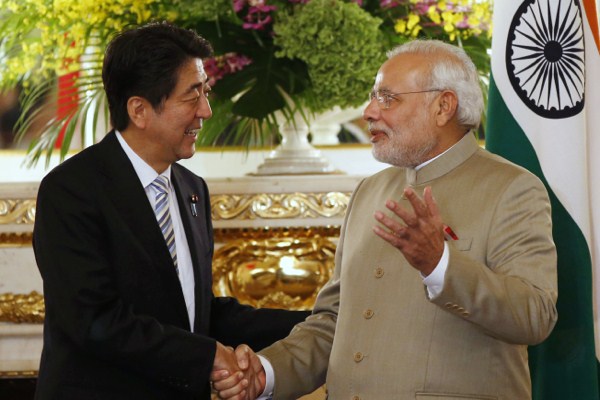Indian Prime Minister Narendra Modi’s visit to Japan in the first week of September generated huge expectations in both New Delhi and Tokyo. During Modi’s first bilateral visit outside the subcontinent, Tokyo and New Delhi agreed to upgrade their annual strategic dialogue to the level of foreign and defense ministers. Tokyo also lifted its ban on six Indian firms involved in defense research and development, which dated back to India’s 1998 nuclear weapons tests, paving the way for the transfer of Japanese military technology to India. Japanese Prime Minister Abe also assured Modi that Japan will invest around $35 billion in the Indian economy in the next five years. These developments suggest that the India-Japan strategic partnership has indeed moved to the next level.
India and Japan are coming together because of China’s steady rise and growing assertiveness, which has unnerved Asia’s regional powers. India and Japan have both found themselves on the receiving end of China’s expansionist agenda, New Delhi over a territorial dispute with Beijing over their 2800-mile Himalayan frontier, Tokyo over the Senkaku Islands—claimed by China as the Diaoyu—in the East China Sea. Meanwhile, a more hands-off United States, the region’s traditional security guarantor, has left the two countries further concerned. President Barack Obama’s pivot toward the Asia-Pacific has not satisfied Washington’s Asian allies and friends. A slow American economic recovery has also translated into dwindling resources for the Pentagon. Moreover, myriad conflicts in the Middle East and the crisis in Ukraine have taken U.S. focus away from balancing China. In the face of China’s growing power and the uncertainty over U.S. intentions in the region, New Delhi and Tokyo have seen the merits of close strategic cooperation to maintain Asia’s balance of power.
Nevertheless, the euphoria surrounding Modi’s visit was dampened by the impasse on a civilian nuclear cooperation agreement between the two countries. Yet again, the two sides were not able to resolve their differences over India’s nuclear normalization. Japan’s stated anti-nuclear stance has often conflicted with India’s aspirations to be a nuclear weapons state. The bilateral relationship went into a deep freeze after India conducted a series of nuclear tests in 1998. During the U.S.-India negotiations on civilian nuclear energy cooperation undertaken by the George W. Bush administration, Japan communicated its displeasure over India’s accommodation into the global nuclear order. Tokyo, however, relented under Washington’s diplomatic pressure and eventually supported the nuclear deal both at the International Atomic Energy Agency (IAEA) and the Nuclear Suppliers Group (NSG). However, without a separate nuclear agreement with Tokyo, the promise of the U.S.-India nuclear deal remains incomplete.

